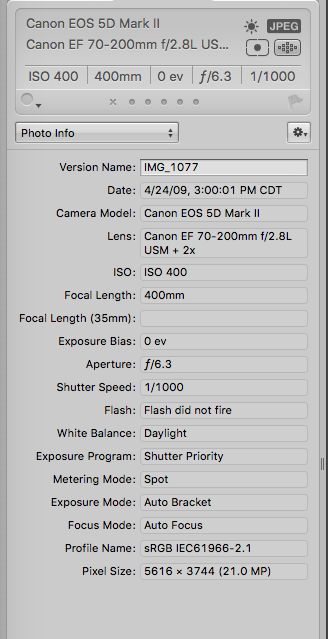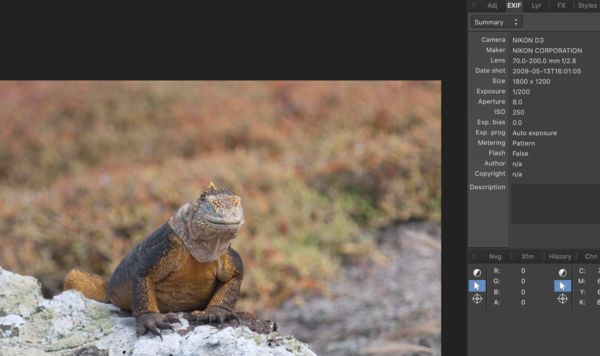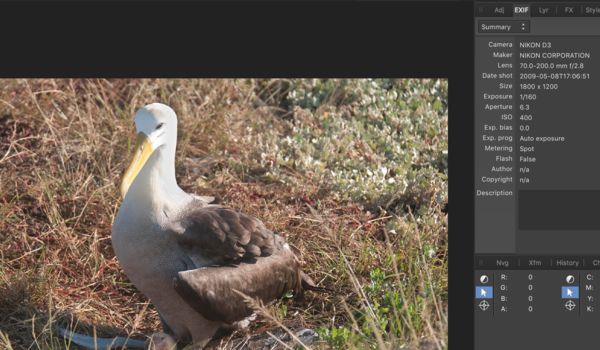Galapagos trip
Apr 15, 2018 10:49:55 #
Hsch39 wrote:
Check your Exif data again. Only 2 photos were taken with the 24-70mm. The Albatross photo was taken at 150mm and the Iguana photo shows 400mm. You probably used a 2x extender.
I am curious to know how the EXIF data can determine that the focal length was 400 mm with the 200 mm lens. I don't see any info for an extender in the EXIF, but that could be because my EXIF view does not show all the fields. Does your EXIF viewer reveal info about an extender?
Apr 15, 2018 10:55:24 #
The exif data does not show the extender, but it shows that the focal length was extended to 400mm.
JohnFrim wrote:
I am curious to know how the EXIF data can determine that the focal length was 400 mm with the 200 mm lens. I don't see any info for an extender in the EXIF, but that could be because my EXIF view does not show all the fields. Does your EXIF viewer reveal info about an extender?
Apr 15, 2018 11:45:02 #
Hsch39 wrote:
The exif data does not show the extender, but it shows that the focal length was extended to 400mm.
But that is the crux of my question: what tells the camera that the focal length is 400 mm? Normally that information is transmitted from the lens zoom setting to the camera. The lens cannot zoom beyond 200 mm, so why is that not the information that is recorded in the EXIF file? The only way for the camera/EXIF to know that the focal length was 400 is for it either to come from the lens (i.e., a 400 mm focal length) or via electronics in a "smart" extender module.
Apr 15, 2018 11:52:25 #
JohnFrim wrote:
But that is the crux of my question: what tells the camera that the focal length is 400 mm? Normally that information is transmitted from the lens zoom setting to the camera. The lens cannot zoom beyond 200 mm, so why is that not the information that is recorded in the EXIF file? The only way for the camera/EXIF to know that the focal length was 400 is for it either to come from the lens (i.e., a 400 mm focal length) or via electronics in a "smart" extender module.
Following this I don't know how it all works but I put a 2x extender on my 100-400mm MII and EXIF goes to 800mm. Yes the lens is only 400mm alone but the camera is smart enough to know that with a 2X extender to multiply the lens length by 2.
Apr 15, 2018 12:00:16 #
Architect1776 wrote:
Following this I don't know how it all works but I put a 2x extender on my 100-400mm MII and EXIF goes to 800mm. Yes the lens is only 400mm alone but the camera is smart enough to know that with a 2X extender to multiply the lens length by 2.
Well, that convinces me that the extender must have enough smarts in it to multiply the focal length setting before it reaches the camera. Thanks.
But now to beat a horse to death... I know that there are many many fields in the EXIF file and not all viewers show all fields. Does anyone know whether there is a field that records the extender information?
Apr 15, 2018 12:49:55 #
Apple/Photos and Affinity will give you the Extender info. I don't know if it works with a Generic extender
JohnFrim wrote:
Well, that convinces me that the extender must have enough smarts in it to multiply the focal length setting before it reaches the camera. Thanks.
But now to beat a horse to death... I know that there are many many fields in the EXIF file and not all viewers show all fields. Does anyone know whether there is a field that records the extender information?
But now to beat a horse to death... I know that there are many many fields in the EXIF file and not all viewers show all fields. Does anyone know whether there is a field that records the extender information?

Apr 15, 2018 13:00:20 #
Apr 15, 2018 13:30:11 #
JohnFrim wrote:
You have received lots of advice about camera lens... (show quote)
Dry bags are an excellent choice. They keep all water out and when once ashore can be easily stored in a backpack carrying ancillary lenses and equipment, snacks and water. Wet landings can get quite wet. I can carry my D4s, 24-70 attached and 70-200 and even 2x extender in a 13 quart bag. Needed that in Panama where all landings were wet and surge while getting out quite common.
Apr 15, 2018 13:41:11 #
Hsch39 wrote:
Check your Exif data again. Only 2 photos were taken with the 24-70mm. The Albatross photo was taken at 150mm and the Iguana photo shows 400mm. You probably used a 2x extender.
I didn’t carry a 400 mm or 2x extender. As far as the iguana, you had to be careful not to step on them. I had been there before and only had the 24-70 mm lens. You are probably correct about the albatross. That particular albatross pic was taken further away because as you may notice, she was sitting on an egg and got nervous when I tried to get closer. I checked the other pics of albatross and I had the 70-200 mm. Many of the other pictures were between 70- 125 mm. My 2x extender didn’t make that trip as it was my second and I knew I wouldn’t need it (no albatross on 1st trip). Don’t know where 400 comes from. My 400 mm was back home in Fort Worth as were my extenders. I stand by my comment that 400mm is overkill.
Apr 15, 2018 14:00:41 #
first go to a marine store and buy a dry bag. then put some foam in it and your camera and the 70 200... YOu wont be shooting stuff from far away. but you will get wet and it can be VERY humid and hot there.
Apr 15, 2018 14:24:32 #
Architect1776 wrote:
Let's not let the truth get in the way of bashing the 100-400mm MII


I did not have a 400 mm or extender on the iguana. I had to avoid stepping on them. They walk where they want and not very fast. It was my second time on that island and knew I didn’t need to carry a long lens. The albatross was at 150mm as she was sitting on an egg and got nervous as I got close. I took 3 lenses and no extenders on that trip 14-24 mm 24-70 mm 70-200 mm. Carry it if you want. If you are quick enough it might help you catch Storm Petrils but I can’t think of much else you would miss.
Apr 16, 2018 06:11:02 #
Meganephron wrote:
I did not have a 400 mm or extender on the iguana.... (show quote)
How do you explain the data?
Apr 17, 2018 09:51:33 #
Architect1776 wrote:
How do you explain the data?
I can’t but as I said it was my second trip there. I knew what to expect on that island and only took one lens. The other pictures from that island show focal lengths between 35-70. You literally had to avoid stepping on them as they didn’t avoid humans and walk very slow. Stood within two feet of one eating on a cactus. These were only on the one island.
Apr 17, 2018 10:43:01 #
All of your four photos were taken on 4 different landings and 3 different days and islands. Your Albatross photo also shows a 70-200 lens in the Exif data. I was there in April of 2009, and probably took the same landings you did.
Meganephron wrote:
I canâÂÂt but as I said it was my second trip there. I knew what to expect on that island and only took one lens. The other pictures from that island show focal lengths between 35-70. You literally had to avoid stepping on them as they didnâÂÂt avoid humans and walk very slow. Stood within two feet of one eating on a cactus. These were only on the one island.


Apr 17, 2018 12:08:20 #
Hsch39 wrote:
All of your four photos were taken on 4 different landings and 3 different days and islands. Your Albatross photo also shows a 70-200 lens in the Exif data. I was there in April of 2009, and probably took the same landings you did.
You are correct about the different islands and days. Yes, the albatross was with the 70-200 mm as she was sitting on an egg and got anxious if I got closer so shot it at 150 mm. I went through the other albatross shot and they were all 70-125 mm with the 70-200 mm lens. This was one of the first stops.
The land iguana was shot on one of the last days in the afternoon stop (3-6 pm). Having been there 3 years earlier, I knew how up close I would be and only had the 24-70 mm lens. Can’t explain the data at 400 mm. Looking at other pictures from that day the data reads between 35-70 mm. Looking at the photo I don’t see the compression expected with a 400 mm lens.
Went with Inca Floats on the Integrity
If you want to reply, then register here. Registration is free and your account is created instantly, so you can post right away.




